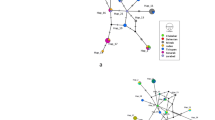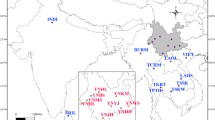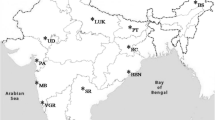Abstract
The melon fly, Bactrocera cucurbitae Coquillett, is a species of fruit flies of significant agricultural interest. Of supposed Indian origin, the melon fly is now widely distributed throughout South East Asia up to China, while it has been recently eradicated from Japan. The population structure of seven geographic populations from coastal China, as well as samples from other regions of South East Asia and Japan, including lab colonies, have been studied using a 782 bp fragment of mitochondrial cytochrome oxidase I (COI) gene sequence. The observed genetic diversity was exceedingly low, considering the geographic scale of the sampling, and one single haplotype was found to be predominant from Sri Lanka to China. We confirm that Bactrocera cucurbitae exists in South East Asia as a single phyletic lineage, that Chinese populations are genetically uniform, and that no apparent genetic differentiation exists between these and three available Japanese melon fly sequences.


Similar content being viewed by others
References
Armstrong KF, Ball SL (2005) DNA barcodes for biosecurity: invasive species identification. Phil Trans R Soc B 360:1813–1823
Avise JC (2000) Phylogeography: the history and formation of species. Harvard University Press, Cambridge (MA)
Baimai V, Phinchongsakuldit J, Sumrandee C, Tigvattananont S (2000) Cytological evidence for a complex of species within the taxon Bactrocera tau (Diptera: Tephritidae) in Thailand. Bio J Linn Soc 69:399–409
Bezzi M (1913) Indian Tephritids (fruit flies) in the collection of the Indian Museum, Calcutta. Mem Indian Mus 3:153–175
Boykin LM, Shatters RG, Hall DG, Burns RE, Franqui RA (2006) Analysis of host preference and geographical distribution of Anastrepha suspensa (Diptera:Tephritidae) using phylogenetic analyses of mitochondrial cytochrome oxidase I DNA sequence data. Bull Entomol Res 96:457–469
Chen JH, Xu ZH, Chen WM, Jin GL, Wang ZL (2006) Notes on five fruit flies in Zhejiang Province. Acta Agricul Zhejiang 18:28–31
Clement M, Posada D, Crandall KA (2000) TCS: a computer program to estimate gene genealogies. Mol Ecol 9:1657–1659
Dhillon MK, Singh R, Naresh JS, Sharma HC (2005) The melon fruit fly, Bactrocera cucurbitae: a review of its biology and management. Insect Sci 5:1–16
Drew RAI, Hancock DL (1994) The Bactrocera dorsalis complex of fruit flies (Diptera: Tephritidae: Dacinae) in Asia. Bull Entomol Res Series 2(Suppl):1–68
Fletcher BS (1987) The biology of dacine fruit flies. Ann Rev Entomol 32:115–144
Hebert PDN, Cywinska A, Ball SL, Dewaard JR (2003) Biological identifications through DNA barcodes. Proc Roy Soc Ser B 270:313–321
Jamnongluk W, Baimai V, Kittayapong P (2003) Molecular evolution of tephritid fruit flies in the genus Bactrocera based on the cytochrome oxidase I gene. Genetica 119:19–25
Koyama J, Kakinohana H, Miyatake T (2004) Eradication of the melon fly, Bactrocera cucurbitae, in Japan: importance of behaviour, ecology, genetics, and evolution. Annu Rev Entomol 49:331–349
Kumar S, Tamura K, Nei M (2004) MEGA3: integrated software for molecular evolutionary genetics analysis and sequence alignment. Brief Bioinform 5:150–163
Liang GQ, Zhang SM, Xu W (1989) The notes of the fruit fly in south part of China and newly recorded species. Acta Agricul Univer Jiangxi 11:14–20
Malacrida AR, Gomulski LM, Bonizzoni M, Bertin S, Gasperi G, Guglielmino CR (2007) Globalization and fruitfly invasion and expansion: the medfly paradigm. Genetica 131:1–9
Matsuyama T, Kuba H (2004) Can the Okinawa mass-reared strain of the melon fly, Bactrocera cucurbitae (Coquillett) (Diptera: Tephritidae) mate with the Taiwan wild strain? Appl Entomol Zool 39:279–282
Meixner MD, Mcpheron BA, Silva JG, Gasparich GE, Sheppard WS (2002) The Mediterranean fruit fly in California: evidence for multiple introductions and persistent populations based on microsatellite and mitochondrial DNA variability. Mol Ecol 11:891–899
Mun J, Bohonak AJ, Roderick GK (2003) Population structure of the pumpkin fruit fly Bactrocera depressa (Tephritidae) in korea and Janpan: Pliocene allopatry or recent invasion? Mol Ecol 12:2941–2951
Nardi F, Carapelli A, Dallai R, Frati F (2003) The mitochondrial genome of the olive fly Bactrocera oleae: two haplotypes from distant geographical locations. Insect Mol Biol 12:605–601
Nardi F, Carapelli A, Dallai R, Roderick GK, Frati F (2005) Population structure and colonization history of the olive fly. Bactrocera oleae (Diptera, Tephritidae) Mol Ecol 14:2729–2738
Palumbi SR (1996) Nucleic acids II: the polymerase chain reaction. In: Molecular Systematics. Sinauer Associates, Sunderland, MA, pp 205–247
Peck SL, Mcquate GT, Vargas RI, Seager DC, Revis HC, Jang EB, Mcinns DO (2005) Movement of sterile male Bactrocera cucurbitae (Diptera: Tephritidae) in Hawaiian agroecosystem. J Econ Entomol 98:1539–1550
Piñero JC, Jácome I, Vargas R, Prokopy RJ (2006) Response of female melon fly, Bactrocera cucurbitae, to host-associated visual and olfactory stimuli. Entomol Exp Appl 121:261–269
Reyes A, Ochando MD (2004) Mitochondrial DNA variation in Spanish populations of Ceratitis capitata (Wiedemann) (Tephritidae) and the colonization process. J Appl Entomol 128:358–364
Saitou N, Nei M (1987) The neighbour-joining method: a new method for reconstructing phylogenetic trees. Mo Biol Evol 4:406–425
Shi W, Kerdelhue C, Ye H (2005) Population genetics of the oriental fruit fly, Bactrocera dorsalis (Diptera: Tephritidae), in Yunnan (China) Based on Mitochondrial DNA sequences. Environ Entomol 34:977–983
Simon C, Frati F, Beckenback A, Crespi B, Hong L, Flook P (1994) Evolution, weighting, and phylogenetic utility of mitochondrial gene sequences and a compilation of conserved polymerase chain reaction primers. Ann Entomol Soc Am 87:651–701
Slatkin M, Hudson RR (1991) Pairwise comparisons of mitochondrial DNA sequences in stable and exponentially growing populations. Genetics 129:555–562
Thompson JD, Gibson TJ, Plewniak F, Jeanmougin F, Higgins DG (1997) The ClustalX windows interface: flexible strategies for multiple sequence alignment aided by quality analysis tools. Nucleic Acids Res 22:4673–4680
Wang XJ, Zhao MZ (1989) Notes on the genus Dacus Fabricius in China with descriptions of five new species. Acta Zootaxon Sinica 14:209–219
Weems HV Jr, Heppner JB (2001) Melon fly, Bactrocera cucurbitae Coquillett (Insecta: Diptera: Tephritidae). Florida Department of Agriculture and Consumer Services, Division of Plant Industry, and T.R. Fasulo, University of Florida. University of Florida Publication EENY- 199
Xie L, Hong XY, Xue XF (2006) Population genetic structure of the twospotted spider mite (Acari: Tetranychidae) from China. Ann Entomol Soc Am 99:959–965
Zhu ZH, Ye H, Zhang ZY (2005) Genetic relationships among four Bactrocera cucurbitae geographic populations in Yunan province. Chinese J Appl Ecol 16:1889–1992
Acknowledgments
We are grateful to Xiao-fei Liu (Yunnan University), Zhi-wen Zou (Jiangxi agricultural University), J. Catindig (International Rice Research Institute), Zhi-hong Xu (Zhejiang University), Xin Qi (National Chung Hsing University), Zheng-qiang Peng (Chinese Academy of Tropical Agriculture Sciences), Chang-ming Liu (Fujian Agriculture and Forestry Univeresity), Areepan Upanisakorn (Department of Agricultural Extension) for collecting samples for the study. We wish to thank two anonymous reviewers for their insightful comments. This research was funded by the National Grand Fundamental Research “973” Program of China (Grant 2002CB111405), the National Natural Science Foundation of China (Grant 30471162) and the Natural Science Foundation of Guangdong Province (Grant 05003324). F.N. was supported by the United States Department of Agriculture.
Author information
Authors and Affiliations
Corresponding author
Rights and permissions
About this article
Cite this article
Hu, J., Zhang, J.L., Nardi, F. et al. Population genetic structure of the melon fly, Bactrocera cucurbitae (Diptera: Tephritidae), from China and Southeast Asia. Genetica 134, 319–324 (2008). https://doi.org/10.1007/s10709-007-9239-1
Received:
Accepted:
Published:
Issue Date:
DOI: https://doi.org/10.1007/s10709-007-9239-1




